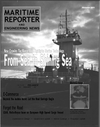
HJ403: Hamilton Unveils New Water jet
Hamilton Jet has released a new wateijet model, the 400 mm HJ403 - replacing the popular HJ391 model. According to the manufacturer, the new unit will offer many benefits over other propulsion systems for high speed work and patrol boats with power inputs up to 900 kW. As with all Hamilton wateijets, the HJ403 is designed to provide excellent high speed and cruising performance and superior cavitation resistance at low speeds and when under loaded conditions. The wide range of impeller options available ensure its compatibility with a variety of engine models, either direct driven or via a gearbox, and the flexibility of the jet unit makes it suitable for many different types of vessel in single or multiple installations.
While the basic specifications of the HJ403 are similar to its predecessor, the new model includes several new design features to improve the installation and operation of the jet. It is available in either zero or five degree shaft angle options to suit different engine alignments and vessel trim, and the jet features a more compact balanced reverse duct with the same superior zero-speed and reverse maneuvering performance and lower actuating loads. The latter allows the unit to utilize a single reverse cylinder with faster response times. The HJ403 is more compact than the previous model, with the intake block positioned further aft against the transom, reduced length between coupling flange and transom, and reduced height from base to fully raised reverse duct. This unit is also lighter than the HJ391. The jet incorporates Hamilton's JT steering system, which minimizes thrust loss when steering. The HJ403 is the first new model to feature stainless steel leading edge inserts in the stator to reduce wear when operated in abrasive conditions. The HJ403 may be configured for manual hydraulic or power assisted steering, while the standard reverse function uses Hamilton's new HFRC Reverse Control System. This servo hydraulic system "decouples" the reverse control levers from the reverse duct movement while providing full follow up control. It also allows quadruple jets to be controlled in pairs using only two reverse controllers.
Circle 2 on Reader Service Card www.maritimereporterinfo.com
Other stories from November 2002 issue
Content
- Bollinger Restructures Management Team page: 8
- I neat Confirms U.S. Military Contract page: 10
- Promoting A Modal Shift page: 12
- FPSO Farwah Launched at Fene Yard page: 16
- The Irony Of Maritime Security page: 18
- Secure Marine Debuts "Fence" at Sea page: 24
- All Set Tracking Launches New Electronic Seal page: 25
- Additional Funding Urged for Port Security page: 26
- Austal to Build Circle Line's First High Speed Vessel page: 27
- Stena Christens Tanker For Coastal Waters page: 29
- New Fast Craft For Kristiansand City F.D. page: 30
- Gladding-Hearn Delivers Fast Ferry for Lake Erie page: 31
- MTU Engine Series Logs Success on Inland Waterways page: 33
- KMSS Training/Simulation Division Is Buoyant page: 34
- Crowley takes lead with "Reliance" page: 36
- Markey Provides the Strong Pull page: 37
- Lerchbacker Puts Austal USA on the Fast Track page: 38
- Field of Dreams page: 41
- Columbian Rope Continues to Hold Strong... After 175 Years page: 42
- Hydralift Skeg Use Gaining Speed page: 44
- Workboat Annual page: 46
- A New Generation of Fireboats page: 48
- Alstom Selected By Otto Candies page: 50
- TechnoFibre Leads In Lifeboat Maintenance page: 50
- Maritime E-Business Growth Continues page: 52
- Wallem, Drew Team to Offer "Total" Solution page: 59
- Marine Software: Aiming to Lower Costs page: 60
- Full Steam Ahead page: 62
- Marine Data Systems Offers AIS Solutions page: 65
- The Holland Project: Leveraging History to Build Tomorrow's Ships page: 66
- John P. Holland: Father of the Modern Submarine page: 70
- MAN B&W Revises 32/40 Engine page: 71
- RIB Report page: 73
- Willard Ready for Defense, Commercial Contracts page: 75
- Griffon Hovercraft Scores Big Contracts Around the World page: 76
- Wartsila s Italian Plant Rolls Out Two Stroke page: 80
- MAN B&W Touts Proven Tech in New 48/60B Engine page: 84
- Manitowoc = 100 Years of Distinction page: 86
- TankRadar System Breaks New Ground page: 87
- North American Marine Jet Expands Its Market page: 87
- HJ403: Hamilton Unveils New Water jet page: 88

